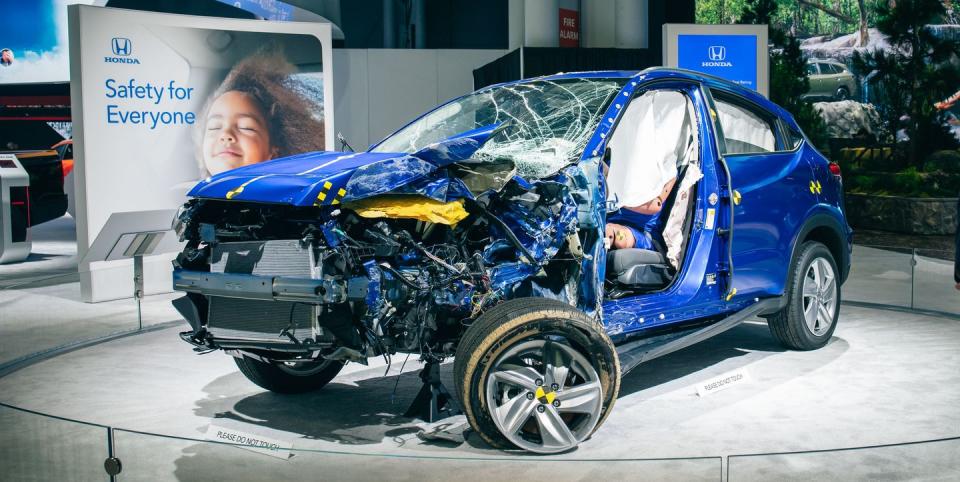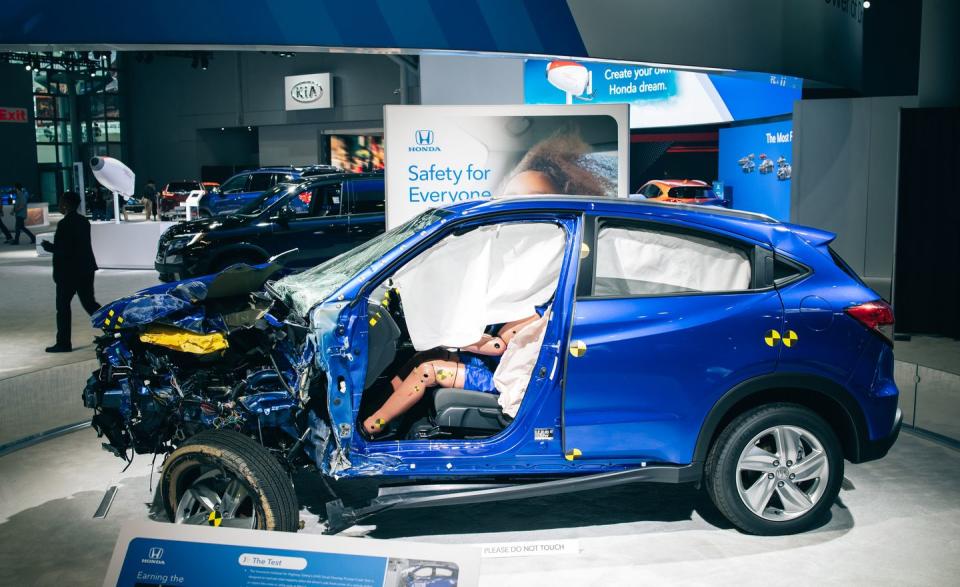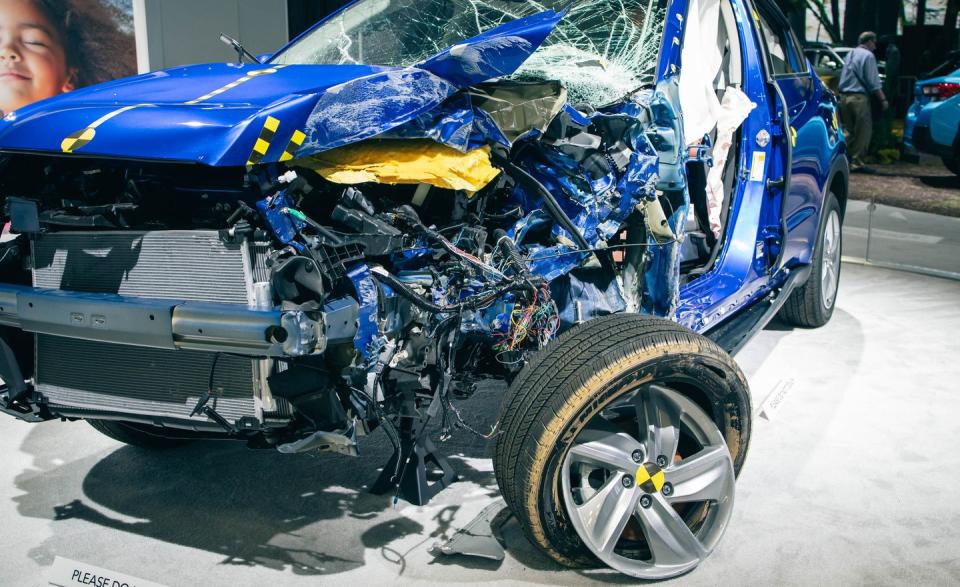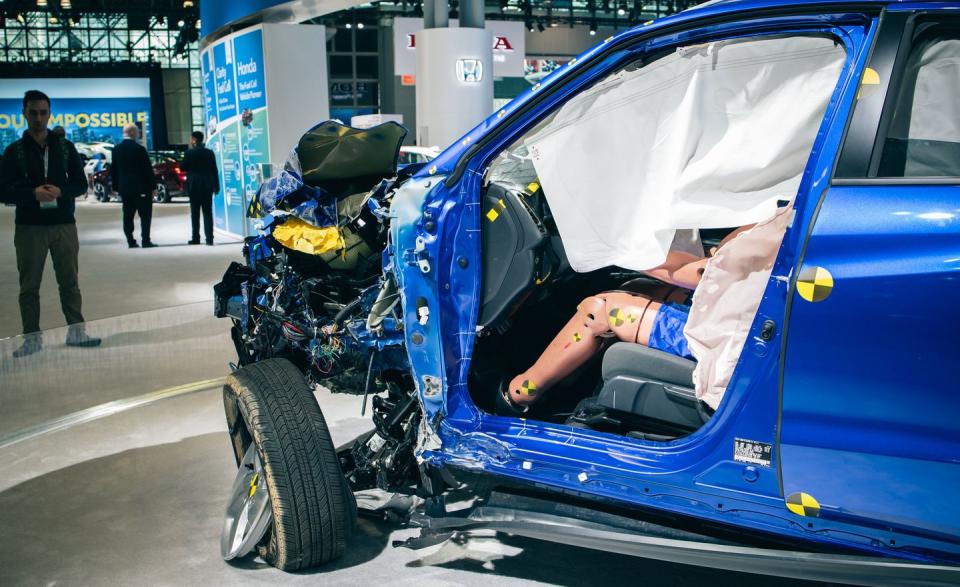Crash-Tested Honda HR-V Shows Advances in Auto Safety Engineering

Honda is displaying a crash-tested HR-V SUV on its New York auto show stand this year.
The wreckage from Insurance Institute for Highway Safety (IIHS) testing is a jarring illustration of how modern cars are engineered to withstand traffic accidents.
Safety engineers are working to integrate both passive and active safety technologies into future vehicles.
If you're planning on wandering the halls of the Javits convention center this weekend for the start of the New York auto show, you might be surprised to find, amid the acres of pristine, perfectly polished sheetmetal, a totaled HR-V parked prominently in the Honda display. Honda brought the HR-V to the show this year to illustrate the industry's concern for crash safety. Even though traffic accident fatality rates have fallen in recent years, the National Safety Council reported that about 40,000 people died on U.S. roads in 2018.
The unfortunate HR-V was used by the Insurance Institute for Highway Safety (IIHS) in the agency's driver's-side small-overlap crash test, which is challenging mainly because it doesn't engage the typical crash structure at the center of the vehicle. The agency introduced a similar test in 2017 for the passenger side—as well as several others, including a headlamp performance test. The addition of the new tests promptly shortened the list of vehicles eligible for the top awards of Top Safety Pick and Top Safety Pick+.
Dissipating Energy
During a walkaround of the HR-V, Brian Bautsch, manager of automotive crash safety for Honda, explained that the HR-V's body structure helps absorb impacts such as those experienced in the small-overlap crash test. He described the car's ACE body structure—an abbreviation for Advanced Compatibility Engineering—as "a multitude of frames, structures, and joints that enable us to dissipate the energy no matter what crash condition and scenario we encounter."
Bautsch pointed to dimples in the car's Aegean Blue body panels as evidence that the structure had done its job: distributing energy along the side of the car and up and over the cabin.

As Bautsch explained it, the car's structure is designed to distribute the energy "load" in three directions to protect the occupants inside the vehicle. In a crash, energy is dissipated across the bumper and back to the other side; up the A-pillar over the roof rail; and down the side sill, all the way to the ground.
IIHS performs six tests of crashworthiness, and the HR-V achieved the top score of Good in all of them, including both driver's-side and passenger-side small-overlap crash tests—which could be one explanation of how the small SUV was selected to make this star turn at the Javits center.
Designing Safety In
During the development of a new vehicle, manufacturers perform their own safety evaluations so that when it's time to hand over a completed model for testing there are no surprises.
"We do hundreds, if not thousands, of virtual simulations prior to actually getting a prototype and testing," Bautsch said, explaining that the test simulations help the automaker "tune and change the design and be more efficient in understanding the cost and weight implications."
The HR-V–along with six other Honda models–earned a Top Safety Pick award from IIHS for 2019, but that's not the case with all subcompact crossovers. Of the growing number of SUVs in this smallest size class running around on American roads, the BMW X2, the Honda HR-V, the Hyundai Kona, the Kia Niro and Soul, the Mazda CX-3, the Nissan Kicks, the Subaru Crosstrek, and the Volvo XC40 received Top Safety Pick or Top Safety Pick+ awards this year.

Honda's smallest crossover missed out on the "+" part of the award because its headlamp performance didn't meet IIHS's extremely exacting standards, which examine field of view at night and also take into consideration glare affecting both the driver and and drivers of oncoming vehicles. We won't be surprised to see Honda make the changes it needs to make to get the HR-V into that + column in the very near future.
As for expected changes to crash-testing standards, Honda safety spokesman Chris Martin explained that while IIHS may be able to move the bar every year, governmental regulations—which affect the National Highway Traffic Safety Administration (NHTSA) test standards—tend to move more slowly, but that agency also changes and adapts its testing over time.
Active-Safety Features as Accident Prevention
The next frontier for automotive safety is coming in the form of high-tech driver-assistance features that are becoming increasingly common but aren't yet mandatory. Radar-, sonar-, and camera-based systems such as automated emergency braking, adaptive cruise control, lane-keeping assist, pedestrian detection, and automatic high-beam headlamps are no longer limited to expensive luxury cars and can now be found in run-of-the-mill Toyotas and regular Chevrolets—as well as, of course, Hondas. The Honda Sensing suite of active-safety equipment is standard on the company's popular Civic and Accord sedans as well as the Pilot and Passport SUVs, and the trend toward making automated emergency braking, lane-keeping assist, and other advanced safety features standard is sure to continue. Martin noted that Honda, along with most major automakers, has signed a memorandum of understanding with IIHS and NHTSA to have automated emergency braking on all vehicles by 2022.
"If you can't prevent a collision, from an energy standpoint, slowing down that vehicle by 5, 10, even 15 mph is a huge advantage, and it puts less stress on the vehicle's structure and airbags," said Bautsch. Mitigating injury, it goes without saying, is better for the people inside as well.

You Might Also Like

 Yahoo Autos
Yahoo Autos 